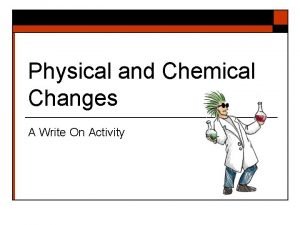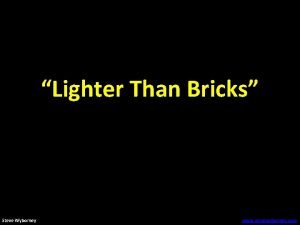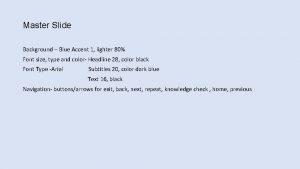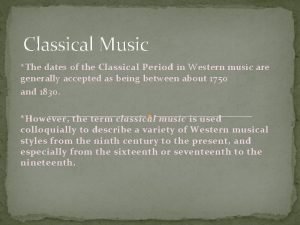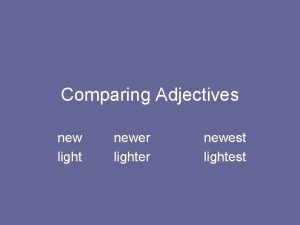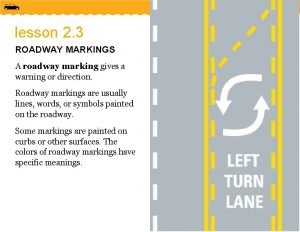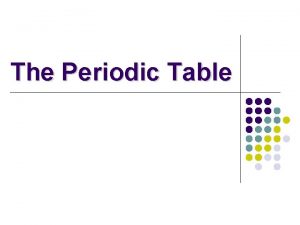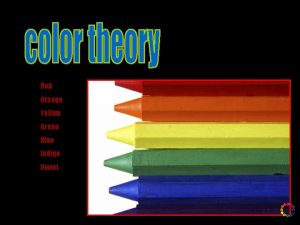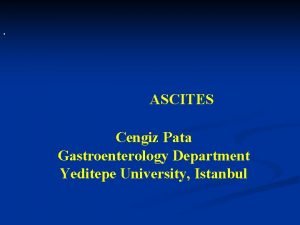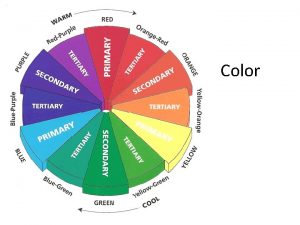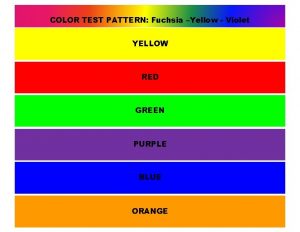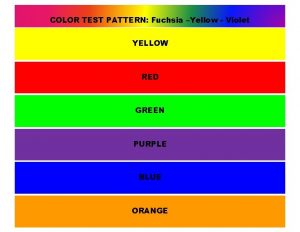Physical Characteristics 1 Color Light yellow Lighter in




























- Slides: 28


Physical Characteristics 1 -Color Light yellow Lighter in color than dentin 2 - Thickness Acellular cementum (20 -50 m) Cellular cementum (150 -200 m) 3 - Permeability Permeable from dentin and PDL sides. Cellular C is more permeable than acellular C.

Chemical Composition 45 -50 % Inorganic substances Hydroxyapatite crystals 50 -55% Organic substances Collagen protein Polysaccharides Trace elements Cementum contains the greatest amount of fluoride in all mineralized tissues

Cementum Structure Malassez Cementocytes Cementoid layer Acellular cementum Cellular cementum

Acellular Cementum Thickness is 20 -50 µ. It is clear and structureless Covers the coronal half of the root. Incremental lines of Salter are parallel to the surface. Sharpey’s fibers space can be seen in it. Alternating layers of a cellular and cellular cementum could be seen.

Cellular Cementum Lacunae of cementocytes Incremental lines of Salter Cementocytes PDL side Dentin side Cementocytes

Cementocyte And Osteocyte Dentin side Lacuna Canaliculi PDL side Osteocyte

Cementocyte And Osteocyte Dentin side Osteocyte Lacuna Canaliculi Periodontal ligament side

Cellular Cementum Dentin side Degenerated deep layer’s cementocytes Viable superficial cementocytes PDL side

Cementoid • The uncalcified matrix of cementum is called cementoid. • It is lined by cementoblast. • Connective tissue fibers from the PDL are embedded in the cementum and serve to attach tooth to surrounding bone (Bone bundle) • These embedded fibers are known as Sharpey`s fibers.

Acellular- Cellular • Acellular • Cementoblast are absent • Covers the root from CEJ to the apex • Predominates in the coronal half of the root • Sometimes found on the surface of cellular cementum • Cellular • Cementoblasts are seen • Seen in apical 3 rd of root • Predominates in the apical half of root • Frequently seen on the surface of acellular cementum

Incremental Lines Of Salter In acellular C In cellular C They are hypermineralized area with less collagen fibers and more ground substance

Cemento Dentinal Junction D C Smooth in permanent teeth Scalloped in deciduous teeth

Cemento Enamel Junction Touching: 30% cementum meets the enamel in a sharp line Gapping: 10% cementum and enamel doesn’t meet because of delayed separation of epith root sheath of Hertwig (area of dentin not covered by C). Overlapping: 60% cementum overlaps E (afibrillar cementum)

3 -Intermediate cementum • Sometimes dentin is separated from the cementum by a zone known as intermediate cementum. • This layer is seen mostly in apical 2/3 rd of Molars and Premolars. • This layer represents areas where cells of Hertwig`s epithelial root sheat become trapped in a rapidly deposited dentin or cementum matrix. • It is rarely seen in primary and anterior teeth.

4 -Afibrillar cementum (No fibril) • Cementoblasts contact enamel surface produce afibrillar cementum • Afibrillar cementum contacts connective tissue cells and forms fibrillar cementum.

Types Of Cementum • 1 - Acellular cementum • 2 - Cellular cementum • 3 - Intermediate cementum • 4 - Afibirllar cementum

Functions Of Cementum 1 - Acts as a medium for attachment of collagen fibers of PDL (Sharpey’s fibers) that bind tooth to alveolar bone. 2 - The continuous formation of cementum keeps the attachment apparatus intact (undamaged). Cementoid T Cementoblast

3 - Cementum deposition apically compensate (balance) for the attrition. 4 - It is a major reparative tissue and protect dentin. ( as in case of fracture or resorption of root)

Cementogenesis • 1 - Matrix formation Collagen fiber type I Ground substance • 2 - Maturation Hydroxy apatite crystals

1 - Matrix formation • Cementum is formed during root formation Cementoblasts D HER Future C E J Epith. Diaph.

Cementoblast is a protein forming and secreting cell. Cementoblast D Collagen fibers + ground substance. Large open face nucleus RER Golgi apparatus Mitochondria Secretory granules Alkaline phosphatase

Cementoid layer Cementoblasts Cementum

Age Changes Of The Cementum 1 - Hypercementosis. Localised D Is abnormal thickening of cementum. May affect one tooth or all teeth D Hypercementosis

Types Of Hypercementosis hypertrophy Increase number of Sharpey’s fibers Hypercementosis hyperplasia Decrease number of Sharpey’s fibers

Types Of Hypercementosis

2 - Permeability From dentin side remains at apical area ONLY From periodontal side, but remain at the superficial recently formed layers

Clinical considerations • Cementum is more resistant to resorption than bone because cementum is avascular; bone is vascular. • Cemental resorption is repaired by formation of cellular or acellular cementum or by both. This is called anatomic repair. • Thin layer of cementum is deposited on the surface of a deep resorption. in such areas, the periodental space is restored to its normal width by formation of a bony protection. This is called functional repair.
 Is lighter fluid burning a physical change
Is lighter fluid burning a physical change Light light light chapter 23
Light light light chapter 23 Light light light chapter 22
Light light light chapter 22 Light light light chapter 22
Light light light chapter 22 Kingsford lighter fluid msds
Kingsford lighter fluid msds Return air and supply air
Return air and supply air Wyborney
Wyborney Blue accent 1 lighter 80
Blue accent 1 lighter 80 The dates of the classical period are
The dates of the classical period are Know the lingo poetry answer key
Know the lingo poetry answer key Peripheral device
Peripheral device To be in love is to touch with a lighter hand
To be in love is to touch with a lighter hand Comparing weights
Comparing weights Comparative degree of light
Comparative degree of light Shared center lane
Shared center lane What to do when you see red raised roadway markers
What to do when you see red raised roadway markers Red orange yellow green blue purple pink brown
Red orange yellow green blue purple pink brown Yellow light
Yellow light A hanging critical essay example
A hanging critical essay example The color white in the great gatsby
The color white in the great gatsby Color wheel personality test
Color wheel personality test Gangs colors and symbols
Gangs colors and symbols Color the square for hydrogen pink
Color the square for hydrogen pink Red orange yellow green blue purple violet
Red orange yellow green blue purple violet Ascites yellow color
Ascites yellow color Magenta cyan and yellow are the ____ color. *
Magenta cyan and yellow are the ____ color. * Put out the light then put out the light
Put out the light then put out the light Distinguish between photosystem 1 and photosystem 2
Distinguish between photosystem 1 and photosystem 2 Bouncing off of light
Bouncing off of light
